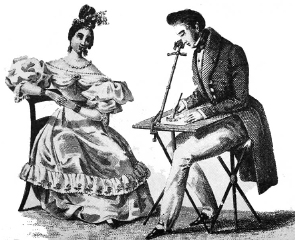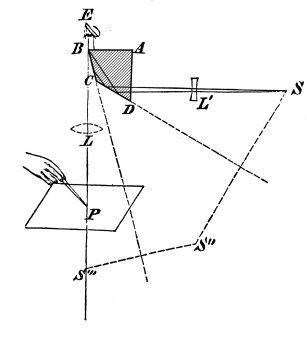Camera lucida
|
|
- See Camera Lucida for the book by French literary critic Roland Barthes.
A camera lucida is an optical device used as a drawing aid by artists. It was patented in 1806 by William Hyde Wollaston.
The camera lucida performs an optical superimposition of the subject being viewed and the surface on which the artist is drawing. The artist sees both scene and drawing surface simultaneously, as in a photographic double exposure. This allows the artist to transfer key points from the scene to the drawing surface, thus aiding in the accurate rendering of perspective. The artist can even trace the outlines of objects in the scene.
If white paper is used, the superimposition of the paper with the scene tends to wash out the scene, making it difficult to view. When working with a camera lucida it is beneficial to use black paper and to draw with a white pencil.
The camera lucida is still available today through art-supply channels, but is not well-known or widely used. As recently as a few decades ago it was, however, still a standard tool of microscopists. Until very recently, photomicrographs were expensive to reproduce. Furthermore, in many cases, a clear illustration of the structure that the microscopist wished to document was much easier to produce by drawing than by micrography. Thus, most routine histological and microanatomical illustrations in textbooks and research papers were camera lucida drawings rather than photomicrographs.
The name "camera lucida" (Latin for "lit room") is obviously intended to recall the much older drawing aid, the camera obscura (Latin for "dark room"). There is no optical similarity between the devices. The camera lucida is a light, portable device that does not require special lighting conditions. No image is projected by the camera lucida.
In the simplest form of camera lucida, the artist looks down at the drawing surface through a half-silvered mirror tilted at 45 degrees. This superimposes a direct view of the drawing surface beneath, and a reflected view of a scene horizontally in front of the artist. The instrument often includes a weak negative lens, creating a virtual image of the scene at about the same distance as the drawing surface, so that both can be viewed in good focus simultaneously.
The original Wollaston camera lucida, as shown in the diagram to the right, uses an erecting prism. The direct and reflected scenes are superimposed by arranging the apparatus so that only half of the pupil of the eye E views through the prism, viewing the drawing surface P directly. The other half views an erect image of the subject reflected from two sides of prism ABCD. Lenses L and/or L' equalize the optical distances of the viewing surface and subject.
While on honeymoon in Italy in 1833, the photographic pioneer William Fox Talbot used a camera lucida as a sketching aid. He later recorded that it was disappointment with his resulting efforts which encoraged him to seek a means to "cause these natural images to imprint themselves durably".
In 2001, artist David Hockney created a storm of controversy with his book Secret Knowledge: Rediscovering the Lost Techniques of the Old Masters. In it, he suggests that great artists of the past, such as Ingres, Van Eyck, and Caravaggio did not work freehand, but were guided by optical devices, specifically an arrangment using a concave mirror to project real images. His evidence is based entirely on the characteristics of the paintings themselves. His work may arouse fresh interest in the use of optical devices as aids to draughtsmanship.


